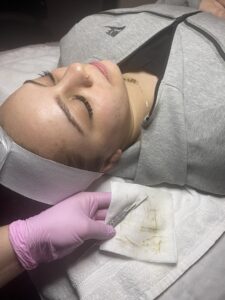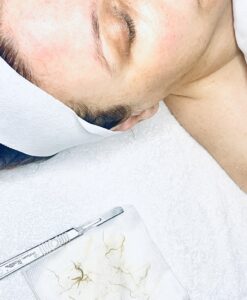Dermaplaning, a popular skincare procedure, involves using a surgical scalpel to gently scrape away dead skin cells and fine vellus hair (peach fuzz) from the surface of the skin. It’s often used to improve the skin’s texture and appearance, leaving it smoother and more radiant.


Here are some skin procedures that dermaplaning may complement or enhance.
Dermaplaning can be performed before a chemical peel to enhance its effectiveness.
By removing the top layer of dead skin cells and hair, dermaplaning allows the chemical peel solution to penetrate more deeply, resulting in a more even and intense exfoliation.
- Enhanced Penetration: Dermaplaning removes the outermost layer of dead skin cells and fine vellus hair (peach fuzz) from the skin’s surface. By doing so, it creates a smoother and more even skin texture, allowing the chemical peel solution to penetrate more deeply and evenly into the skin. This enhanced penetration can lead to more effective exfoliation and better results from the chemical peel.
- Improved Results: When dermaplaning is performed before a chemical peel, the combination can lead to more dramatic results compared to using either treatment alone. The chemical peel can target deeper layers of the skin, addressing concerns such as fine lines, wrinkles, uneven pigmentation, and acne scars, while dermaplaning enhances the overall exfoliation and skin renewal process.
- Even Application: Dermaplaning creates a smoother canvas by removing surface irregularities, allowing the chemical peel solution to be applied more evenly across the skin. This helps to avoid patchy or uneven results and ensures that the entire treatment area receives uniform exfoliation and rejuvenation.
- Reduced Downtime: While chemical peels can sometimes cause redness, flaking, and peeling as the skin undergoes the exfoliation process, dermaplaning can help minimize these side effects. By prepping the skin and removing dead cells and hair, dermaplaning can reduce the intensity and duration of post-peel flaking and peeling, leading to a faster recovery and less downtime.
- Brighter, Smoother Skin: Combining dermaplaning with a chemical peel can result in a brighter, smoother complexion with improved texture and tone. The dual exfoliation process removes dull, damaged skin cells, revealing fresh, healthy skin underneath. This can lead to a more youthful appearance and a radiant glow.
Overall, the combination of dermaplaning and chemical peels can provide comprehensive exfoliation, rejuvenation, and skin renewal benefits, making it an excellent choice for individuals looking to improve the appearance and health of their skin. However, it’s essential to consult with a qualified skincare professional or dermatologist to determine the most suitable treatment plan based on your skin type, concerns, and goals.
Similar to dermaplaning, microdermabrasion exfoliates the skin to remove dead cells and improve its texture.
Combining dermaplaning with microdermabrasion can provide a deeper exfoliation and may be particularly beneficial for individuals with thick or congested skin. Dermaplaning and microdermabrasion both exfoliate the skin, but they do so in slightly different ways. Dermaplaning involves using a surgical scalpel to manually remove dead skin cells and fine hair from the skin’s surface, while microdermabrasion utilizes a mechanical or diamond-tipped device to gently abrade the outer layer of the skin. By combining these techniques, you can achieve a more thorough and comprehensive exfoliation that targets multiple layers of the skin.
Individuals with thick or congested skin often have a buildup of dead skin cells, oil, and debris on the surface, leading to rough texture, clogged pores, and dullness. Dermaplaning and microdermabrasion work together to effectively remove this buildup, revealing smoother, brighter skin underneath. The combination can help unclog pores, reduce the appearance of blackheads and whiteheads, and improve overall skin clarity.
By removing the outer layer of dead skin cells and surface debris, dermaplaning and microdermabrasion create a clean canvas for skincare products to penetrate more deeply into the skin. This allows active ingredients in serums, moisturizers, and other skincare products to be more effectively absorbed, leading to better results. Exfoliation triggers the skin’s natural renewal process, stimulating the production of new, healthy skin cells. Combining dermaplaning with microdermabrasion can further enhance this process, promoting faster cell turnover and revealing fresher, more youthful-looking skin.
Thick or congested skin often exhibits uneven texture, including rough patches, bumps, and irregularities. Dermaplaning and microdermabrasion work synergistically to smooth out these imperfections, resulting in a more even skin tone and texture. The intensity and depth of both dermaplaning and microdermabrasion can be adjusted to suit individual skin types and concerns. This allows skincare professionals to tailor the treatment to each client’s specific needs, whether they have thick, congested skin or other complexion issues.
Overall, combining dermaplaning with microdermabrasion provides a comprehensive approach to exfoliation that can benefit individuals with thick or congested skin by addressing multiple concerns and revealing smoother, healthier-looking skin. However, it’s important to consult with a qualified skincare professional or dermatologist to determine the most appropriate treatment plan based on your skin type, concerns, and goals.
Dermaplaning prior to microneedling can enhance the results of both procedures.
Dermaplaning removes the outer layer of dead skin cells and hair, allowing the microneedling device to penetrate more deeply and evenly. This combination can stimulate collagen production and improve the appearance of scars, wrinkles, and uneven skin tone.
Combining dermaplaning with microdermabrasion and microneedling can offer several benefits for skin rejuvenation and enhancement:
- Enhanced Exfoliation: Dermaplaning, microdermabrasion, and microneedling all work to exfoliate the skin by removing dead cells and promoting cell turnover. When used together, they provide a comprehensive exfoliation process, resulting in smoother, softer skin with improved texture and tone.
- Deeper Product Penetration: Dermaplaning creates a smooth surface by removing the outer layer of dead skin cells and fine hair. This allows for better penetration of skincare products applied during or after the procedure. Microdermabrasion and microneedling further enhance product absorption by creating micro-channels in the skin, allowing active ingredients to penetrate more deeply for better results.
- Stimulated Collagen Production: Microneedling stimulates the skin’s natural collagen production by creating tiny micro-injuries. When combined with dermaplaning and microdermabrasion, it can enhance collagen synthesis even further, leading to improved skin firmness, elasticity, and overall youthfulness.
- Reduced Appearance of Scars and Wrinkles: The combination of dermaplaning, microdermabrasion, and microneedling can help reduce the appearance of scars, wrinkles, and fine lines. By promoting cell turnover and collagen production, these treatments can smooth out uneven skin texture and diminish the appearance of imperfections over time.
- Customized Treatment: Each of these procedures can be tailored to address specific skin concerns and areas of the face or body. By combining them, skincare professionals can create a customized treatment plan that targets multiple concerns simultaneously, such as acne scars, hyperpigmentation, uneven skin tone, and signs of aging.
- Minimal Downtime: While individual results may vary, the downtime associated with dermaplaning, microdermabrasion, and microneedling is typically minimal compared to more invasive procedures. This makes them suitable for individuals with busy lifestyles who may not have time for extended recovery periods.
Overall, combining dermaplaning with microdermabrasion and microneedling can provide synergistic benefits for improving skin texture, tone, and appearance. However, it’s essential to consult with a qualified skincare professional or dermatologist to determine the most appropriate combination of treatments based on your unique skin type, concerns, and goals.
Other great skin procedures to combine with Dermaplaning:
- Facials: Incorporating dermaplaning into a facial treatment can enhance the overall exfoliation and rejuvenation of the skin. It can be combined with other facial treatments such as extractions, masks, and serums to address specific skin concerns and achieve a brighter, smoother complexion.
- Laser Treatments: Dermaplaning can be performed before certain laser treatments to prepare the skin and optimize the results. By removing the outer layer of dead skin cells and hair, dermaplaning helps the laser energy penetrate more deeply into the skin, making the treatment more effective.
- Skincare Product Absorption: By removing the barrier of dead skin cells and hair, dermaplaning can enhance the absorption of skincare products applied to the skin afterward. This allows serums, moisturizers, and other products to penetrate more deeply and deliver their active ingredients more effectively.
Before combining dermaplaning with other skin procedures, it’s essential to consult with a qualified skincare professional or dermatologist to ensure that it’s safe and suitable for your skin type and concerns. Additionally, proper post-procedure skincare and sun protection are crucial to optimize results and minimize the risk of adverse effects.
